-
Posts
11,151 -
Joined
Content Type
Profiles
Forums
Store
Help Articles
Posts posted by slkinsey
-
-
Knowing that I had an extremely knowledgeable bartender on my side, I felt it would be a waste to order off the menu again.
It may be a mistake to think it's a "waste to order off the menu," unless you've tried everything on the menu. The menu was compiled by Audrey Saunders and features many of her creations. Audrey is one of the foremost creators of cocktails working today, and it would be a shame to miss out on any of her drinks. Don't miss out on the Tantris Sidecar, the Punt e Mes Fizz, the Gin Gin Mule, the Old Cuban and the Earl Gray MarTEAni. . . and don't be afraid to ask about any other Saunders specials (the "Dreamy Dorini Smoking Martini" is a favorite of mine).
This is to say that a big part of what makes Pegu Club special is what Audrey and partners have done in bringing together one of the top bar staffs in the country, laying down the vibe and giving the talented staff unprecedented space in which to work and materials with which to work. But a big part of it is also just Audrey.
-
I . . . find myself making things (in addition to blanching veggies as above) such as Alfredo sauce, hot fudge sauce, tomato sauce, etc.
Would one pan design be suitable for all these kinds of tasks? If so, from the perspective of not burning things and having the most control, to my way of thinking it seems logical that straight gauge might be better than a disk bottom--but I wanted to check in with you and get your opinion on this as I am just a novice and you actually know what you are doing!
It still depends on what you already have in your kitchen, what volumes you are cooking and what size pan you are talking about. In the size saucepan that is likely to be useful for blanching vegetables, it's still not clear to me that there is a great deal to be gained by purchasing a straight gauge pan. For something you are likely to make in small amounts -- like melting chocolate -- it can certainly make sense to buy a straight gauge pan in the 1 - 2 quart size, although of course you can always just use a metal bowl above a saucepan of simmering water.
For the other things you describe, it strikes me that either a) extra control isn't particularly required; or b) a saucepan isn't the pan I would choose anyway.
I was wondering if you have had any experience with [the Calphalon One] line?I've picked up a few of the pieces to see how they feel. Ultimately, I'm not convinced that it's all that different from their previous lines and isn't just a marketing strategy. Reports are that the larger diameter pieces are still just as prone to warping from high heat cooking as they always have been, which is an inherent problem with aluminum cookware at this thickness. It's also not clear to me that they are substantially easier to keep clean, which is a major issue with anodized aluminum.
That said, someone with a different cooking style than mine (in particular someone who uses smaller diameter pans and doesn't like to preheat over high flame) might like them very much.
-
I do think it is taking local pride a little overboard to suggest that San Francisco is the best cocktail city in the nation. That said, they do have a number of excellent bars and some highly skilled bartenders there, if not in the same density that we have in NYC, and have their own piece of the cocktail renaissance.
I may be mistaken on this point, but if memory serves, think SF was probably ahead of NYC in terms of cocktail bars using only fresh juices.
I wonder if any eGulleters familiar with the SF scene could comment on whether there is any identifiable "SF style" at the best San Francisco watering holes. In NYC, I guess I would broadly assert that the leading places have a decidedly old school outlook, and that even new drinks which are invented have a basic foundation and design consistent with traditions from the cocktail's glory days (not too many of them are working with flavored vodkas mixed with fruit juices and Alizée, etc.). On the other hand, SF is quite close to some of the best makers of flavored vodkas (Hanger One, etc.), and I wonder if this has influenced the style there. Many of the drinks mentioned in the article seemed to be flavored vodka drinks.
-
Fee's mint bitters is one of those products that sounds like a great idea to most everyone who hears about it. But in practice, reception has been quite mixed. Some people enjoy it and others hate it. Overall, my impression is that most people fall into the latter camp.
Regardless, I'm not sure I like the idea of adding mint bitters to something that is already mint flavored. Similarly, I probably wouldn't add orange bitters to a cocktail that already had a strong orange note, Angostura to something with cinnamon, etc. I guess I feel that there's not much point to adding more of the same flavor because it's not adding any complexity. This is why I find a lot of modern "new school" cocktails uninteresting (e.g., orange vodka with orange liqueur, orange juice, an orange twist and, of course, a splash of cranberry juice).
So, for a Mojito, I'd much rather see a dash of some other bitters that complements rum. Angostura comes to mind, as does Fee's excellent aromatic bitters.
-
A certain amount of showmanship has been part of the bartending craft ever since there has been a bartending craft. Think of Jerry Thomas pouring a flaming arc of whiskey, boiling water and sugar between two tumblers as he made his famous Blue Blazer (click here for a picture of JT making one). Snapping the shaker back after pouring the last drop into the glass, flaming a twist, twirling the Sazerac glass to coat it with absinthe, flipping a closed Boston shaker in your hand to put the mixing glass on top before shaking, breaking the seal with a special slap, lifting the mixing glass high to watch the last few drops fall back into the metal cup, twirling the muddler in your fingers to shake off the rinsing water, pouring from the crack between the metal cup and the mixing glass instead of using the Hawthorne strainer, etc. -- these are all the sort of things that have been part of a skilled bartender's repertoire. I think we all agree that there is a big difference between these things and the kind of juggling one sees from Vegas-style bartenders.
This is not to say that there is anything wrong with simply measuring the liquors, shaking the drink and straining it into the glass. And there are plenty of highly skilled bartenders who prefer this method.
Ultimately the proof is in the product. If the drink is made with a certain amount of joie de vivre and, dare I say, flair -- that's okay by me so long as the drink is good. All too often for the juggling bartender the product is secondary to the show. Needless to say, this is not the case with respect to the bartenders at Pegu.
In terms of "authenticity" and "old school vibe" it strikes me as entirely appropriate that some of the bartenders at Pegu have more flair in their technique than others.
I do have to say, having been to Pegu Club many times at this point -- sometimes straight to closing -- that I've never seen any flair go over the top there. Maybe once or twice I've seen a metal cup dropped (never one with anything in it). That happens sometimes no matter where you go. I've also been there when the ice in a shaker exploded and the shaker slipped open and rained a little liquid on a customer at the bar. These things happen when you sit at a bar and someone is shaking a drink three feet away from you. I should point out, I suppose, that whoever was doing the shaking when the shaker slipped open was not someone who incorporated any flair -- might even have been Audrey, so it can happen to anyone.
Flair is an interesting topic of discussion in and of itself. If we would like to continue discussion of flair in general, please let's start a thread in the Fine Spirits and Cocktails Forum. I've been wanting to sound out thoughts on flair ever since I saw a competition on television for "World's Best Bartender" -- which as far as I could tell was a juggling contest.
-
Here is the original article:
Abstract:
Newly pressed extra-virgin olive oil contains oleocanthal — a compound whose pungency induces a strong stinging sensation in the throat, not unlike that caused by solutions of the non-steroidal anti-inflammatory drug ibuprofen1. We show here that this similar perception seems to be an indicator of a shared pharmacological activity, with oleocanthal acting as a natural anti-inflammatory compound that has a potency and profile strikingly similar to that of ibuprofen. Although structurally dissimilar, both these molecules inhibit the same cyclooxygenase enzymes in the prostaglandin-biosynthesis pathway.I'm not sure why they say "newly-pressed," since a perusal of the supplementary materials indicates that they used "10 commercial Greek, Italian, and U.S. extra virgin olive oils (Falconero, Laudemio, Frantoio, Calonna, Spitiko, Horio, Lucini, Caroli, Sitia, Olio Santo)" to test for pharyngeal irritation and oleocanthal. It doesn't sound like these were "fresh out of the press" olive oils, although I am sure they hadn't been sitting on the shelf for 18 months. For what it's worth, pharyngeal irritation and oleocanthal concentration were positively associated, with Falconero, Laudemio and Frantoio oils having the most of both (interesting to me, since Frantoio is my "house" oil).
-
Interesting, Kevin. It doesn't really strike me as a "Swizzle," though, when it's made in bulk and strained into a cocktail glass. I'd much rather do something like this:
1.5 oz : Gosling's Black Seal Rum
1.5 oz : Gosling's Gold Rum
1.0 oz : Pineapple Juice
1.0 oz : Orange Juice
.75 oz : Falernum
Dash Angostura bitters
Build in a highball glass with crushed ice, swizzle, top with additional crushed ice and tip in one additional dash of Angostura bitters.
-
Great to see more attention being paid to rye whiskey! It's so much more interesting than bourbon, in my opinion.
Here are the ryes sampled by the Times:
Black Maple Hill Kentucky Straight Rye Whiskey, 18 years old
Hirsch Selection Canadian Rye Whiskey, 10 years old
Hirsch Selection Canadian Rye Whiskey, 12 years old
Hirsch Selection Canadian Rye Whiskey, 8 years old
Jim Beam Straight Rye Whiskey
Michter's Single Barrel Straight Rye
Michter's Straight Rye, 10 years old
Old Overholt Straight Rye Whiskey
Sazerac Kentucky Straight Rye Whiskey, 18 years old
Wild Turkey Kentucky Straight Rye Whiskey
I'm a little disappointed that they didn't try Rittenhouse bonded rye, as I think it is one of the very best on the market. There is also some issue having to do with the "old Michter's" and the "new Michter's" rye, that I would have liked to have seen explained (the old Michter's distillery closed and now it's not clear that the stuff sold as "Michter's" is really the same).
Has anyone had any experience with Old Potrero's 18th Century Style Whiskey, which is 100% rye and only aged 2 years? It's always seemed interesting to me, but is very expensive.
Also glad to see a recipe for the Ward Eight there. Good drink. (I like this recipe better, though.)
-
Having gone to C46's brunch any number of times, I guess I think it's okay. . . good, even. And a remarkable bargain. But having eaten regular meals at C46 any number of times as well, I can also say that I think brunch at C46 pales in comparison to dinner at C46, which is outstanding. For me, since I'm hitching a ride and devoting a fairly substantial chunk of time every time I go to C46, I've decided that it's really only worth it for the food if we go for dinner (which is not to say that brunch isn't often worth it for the company).
-
My definition of decent pie would be nicely browned (on the bottom, slightly charred) and a good cook through with a slightly chewy crust.
The difficulty is in getting the bottom crisped & slightly charred in spots while still preserving the soft pliability of the crust and without browning the toppings. This is more or less impossible to do in a home oven. By the time the bottom is cooked properly, the crust is inevitably dried out a bit too much and the toppings a bit more done than you would like.
I've been cooking pizza at home for years, and have refined my technique quite a bit to get the best result. Here are some examples of pizza I made at home cooked on top of a massively preheated heavy slate stone. They are more or less Neapolitan style.
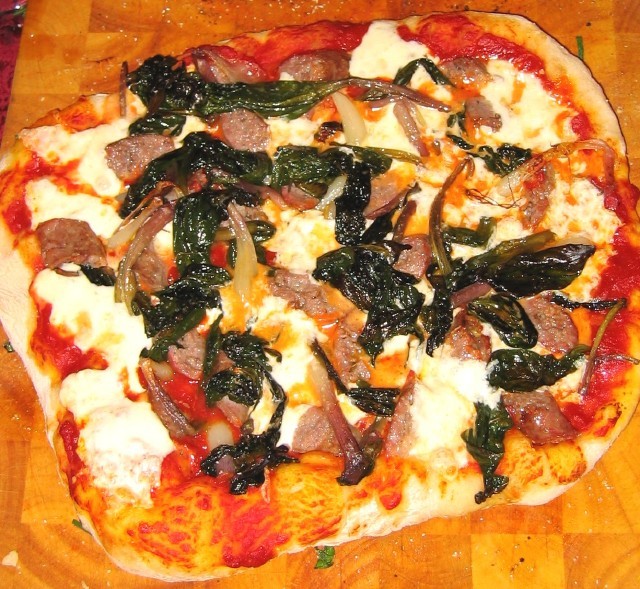
Sausage and ramps.

Margherita.
The yellow color is from olive oil, not browning of the cheese
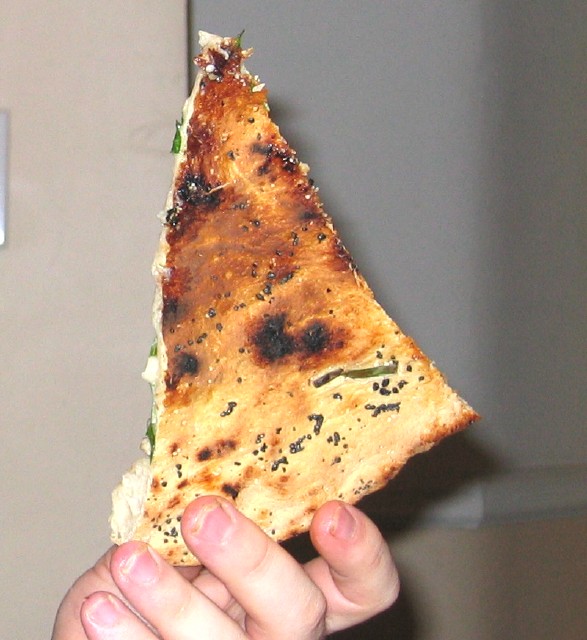
Browning on the bottom of the crust.
This is possible with a very wet dough, stretched very thin, minimally topped and baked on a very heavy stone that has been preheated on the bottom of a gas fired stove for at least an hour. Total cooking time maybe 5 minutes. Even then, the crust tends to be stiffer than I would prefer.
I have a thick rectangular pizza stone, which I pre-heat to 550 F for at least an hour before I put the pizza on it. Takes about 12 minutes for the thin crust pizza I make.It comes out perfect on the bottom, cooked all the way through, without having dried up the sauce, and the mozz is just slightly starting to carmelize.
This has always been a major sticking point for me in using a home oven. I don't want the mozzarella to brown. IMO, a pizza should be dotted with snow white blobs of just-melted fresh mozzarella.
-
I've being developing a growing appreciation of Swizzles, and thought to start a thread where we can discuss our favorites. A Swizzle is loosely defined as a (tall?) drink (usually but not always rum) with crushed ice in which a swizzle stick is rotated so as to aerate and chill the drink (forming a layer of ice on the outside of the glass). Common secondary ingredients include lime juice, bitters (especially Angostura), Falernum and mint.
Here is a fairly common recipe for a Rum Swizzle:
1.50 oz : white rum
0.75 oz : fresh lime juice
0.50 oz : Velvet Falernum
Dash : Angostura bitters
Build in highball glass with crushed ice. Swizzle until frost forms. Top with more crushed ice.
Here's a picture of a rum based swizzle I made with Barbancourt white rum (which is very much not traditional for this drink) and mint.
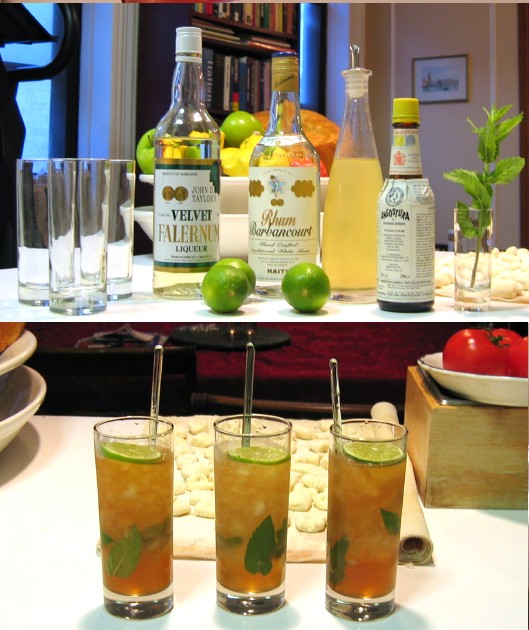
Any favorite swizzle recipes out there?
-
It depends on your definition of "a decent pie."
Can you make a pizza that is as good as what you're likely to get in 95% of American pizzerie out of a stainless steel deck oven? Absolutely. Better, probably.
Can you make a pizza like they're pulling out of the ovens at Franny's or Sally's or Pizzeria Bianco in your home oven? No way.
-
Another thing I learned from observing bartenders like Alchemist flaming twists is that it works best if you use a "disk type" twist rather than a "strip type" twist. A strip is harder to flex sufficiently to get that big spray of oil into the flame (especially without breaking it in half).
-
Heh. Since acquiring a case of "Marie Antoinette" glasses (smaller than the typical "V" glass) I've scaled down my Tombstone to 2 ounces. But I still prefer the drink stirred rather than shaken. I use cracked ice, so dilution is not much of an issue. But I like the heavy silkyness from stirring. Since I'm using home ice straight from the freezer instead of taking ice from a bar bin, I also have the advantage of starting out a lot colder (with home ice, stirring with cracked ice in a chilled pitcher seems to result in the coldest drinks).
-
You know, I've tried these various tricks to make gnocchi lighter. . . baking the potatoes, etc. But ultimately I've never seen any reason to go away from my usual practice of boiling sliced potatoes in water and allowing them to dry in the colander for a few minutes. I don't use eggs in my potato gnocchi, so perhaps I've never needed to take extreme measures for drying (presumably these techniques are used so that less flour is required to bind the dough). But I also feel that it is possible to go too light. If you don't use enough flour, you end up with little lumps of mashed potato that don't have enough integrity to stand up as dumplings.
-
. . . now that I think of it, I bet [oxtail ravioli] would taste really good in an oxtail broth as part of a soup rather than in a tomato sauce as a sauced pasta dish.
Certainly. Tortellini in brodo is very traditional. I'm not big on tortellini in soup that has many other ingredients floating around, but tortellini in a clear broth is one of the best ways to appreciate them.
-
Get a ricer and do Jack's retrogradation trick next time. I guarantee a substantial improvement.

-
I was there on Saturday myself (and, er. . . a good bit of Sunday morning too). It was filled to capacity at around ten or eleven o'clock, at which time was a wait at the door. This was precisely to make sure that it was never "packed to the gills" inside. Inside had the feel and bustle of a filled room, but never felt crowded. Without crowd management at the door, it would have been a madhouse inside. By the time 1:00 or 2:00 rolled around, I don't think there was a wait.
As a general rule of thumb, Saturday night at 10 or 11 is the worst possible time to be out looking for a peak cocktail experience, because even the best places are going to be packed with weekend barhoppers. By limiting the door to control capacity, Pegu Club is actually doing something unusual for an "open admission" bar: they are making it possible to get a peak cocktail experience in a comfortable setting with the full attention of the barstaff even at 11 on Saturday night if you're willing to wait for a while. This, of course, is something restaurants have always done -- we're just used to the idea that bars will cram in as many people as are willing to come through the door.
As another general rule of thumb, Sunday, Monday and Tuesday nights are the best possible times to be out looking for a peak cocktail experience. I'm sure there is no wait at the door to get into Pegu Club tonight, and last night you might have shared the bartender at Flatiron Lounge with only a few other people. Five or six o'clock is also a good time just about any day except Friday.
On another subject: Check out the web site at peguclub.com. If you click on the "Ethos" tab, there is a nice video of a bartender making a Pineapple Pisco Sour and swizzling a Ti Punch (with a real swizzle stick, natch).
-
Those oxtail ravioli look delicious, Ellen! For something really rich like that, I've often found that I like it best minimally sauced (perhaps just moistened with a little reduced braising liquid and butter) and with a lump of cold chevre on top. You take a bit of chevre with each tortellino, and the cool tartness of the cheese really cuts the warm richness of the meat.
-
that's not what I meant (about the preparing ahead)...
I meant that if you're not sure how they will turn out, either gummy or light and fluffy, I would not be confident serving them to guests.. what would I say.. "I spent the afternoon making gnocchi, chances are they taste like wallpaper glue, but, hey, enjoy your dinner everybody"?
Gnocchi really should be made as soon as possible before they are cooked. I wouldn't rest them uncooked more than an hour or two. Here's what I do: While you are making up your gnocchi dough, have a pot of water simmering on the stove. Make one gnocco and toss it in the water to cook. Take it out and taste it. Is it too soft? Add more flour. Is it hard and gummy? Start over or default to something else. Once you have made gnocchi a number of times, though, your skill and judgment will increase and you will gain confidence that it will turn out right every time. If you're worried about a gummy texture from overworking the potato, you can always do Jack Lang's retrogradation trick, which eliminates this concern. Especially if you are not doing Jack's trick, a potato ricer is absolutely de rigeur.
Thinking about potato gnocchi, I decided to make some for dinner last night.

I riced Yukon Gold potatoes directly onto a pastry cloth.
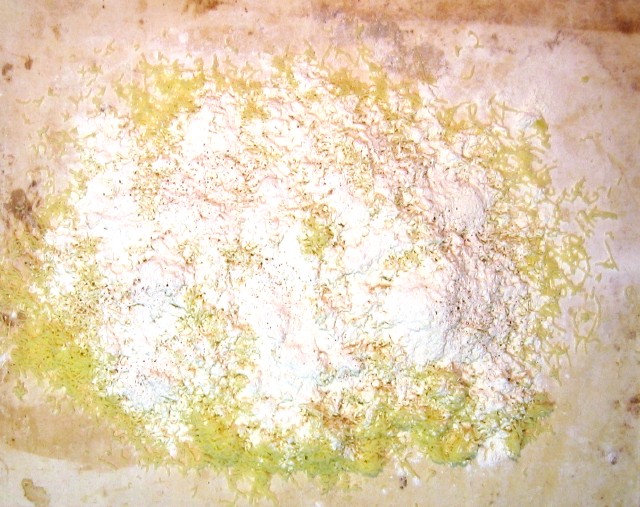
Sprinkled on flour and a small grating of nutmeg. I like using a pastry cloth, because it makes combining the ingredients easy with minimal manipulation of the dough (I didn't have time for Jack's trick tonight). I just pick up one side of the cloth, use the cloth to fold the dough in half, press firmly, repeat until dough holds together, adding a bit more flour as and if necessary.
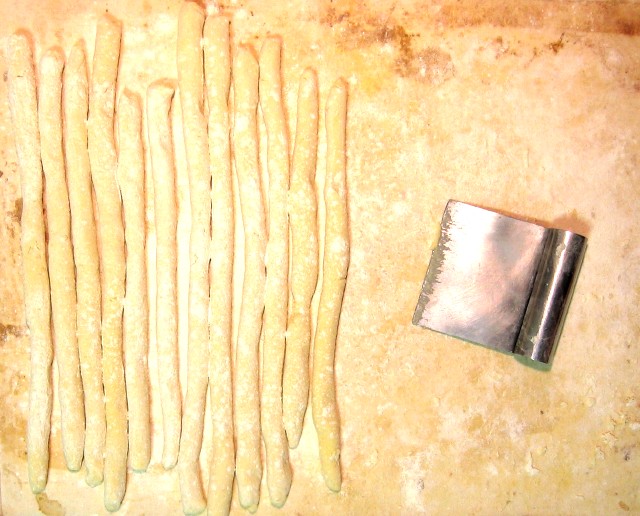
Divide the dough and roll into "snakes." I find that it's much more efficient and easy to "snake" all the dough at once, rather than making one snake of completed gnocchi at a time.
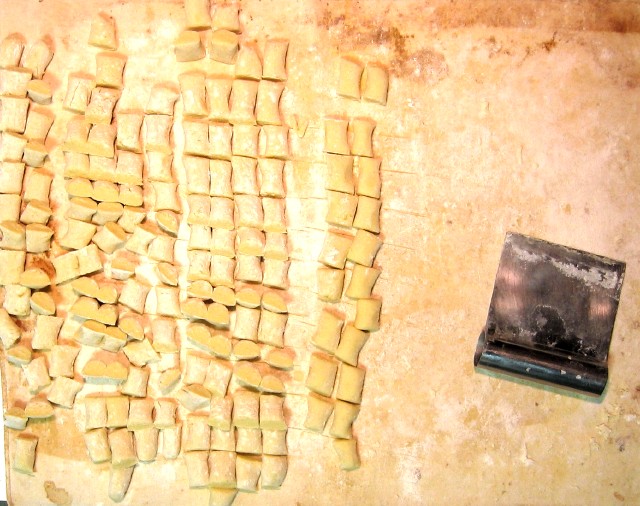
Continuing the bulk production theme, all the snakes are cut into sections. This also makes it easy to make sure that all your gnocchi are the same size.
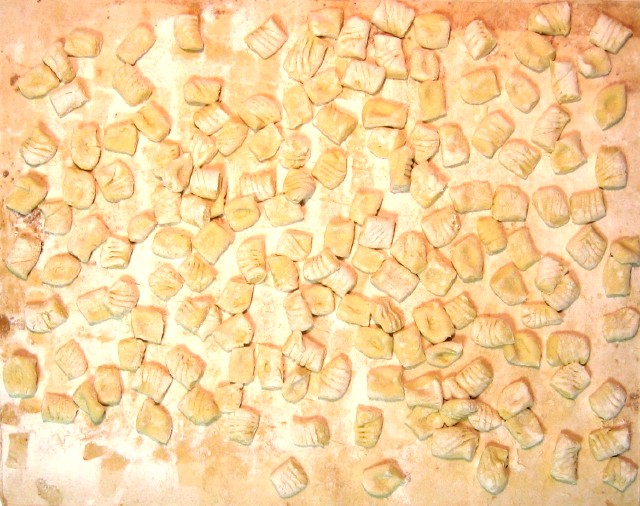
Flick each one off the back of a fork. In my opinion, the dents in the back side of the gnocchi are just as important to sauce adhesion (if not moreso) than the grooves on the front side.

Cooked and sauced with my favorite tomato sauce for gnocchi: San Marzano tomatoes, a halved onion and a good lump of butter started together in a cold pan and slowly brought up to temperature until the butter and tomato emulsify and the onion has given up its flavor.
-
1:1 ginger syrup (infused both hot and cold)
Sam, for the infusion-impaired among us, can you give a simple how-to here about the ginger syrup? I get the 1:1 but not the "hot and cold". And how much of what kind of ginger?
There are two fundamentally different ways you can infuse a flavor into simple syrup:
1. You can heat the simple syrup up and "cook" the flavoring ingredient in the hot syrup; or
2. You can put the flavoring ingredient into room temperature (or colder) syrup.
Different characteristics will emerge depending on how the syrup is infused. With ginger, I find that infusing "hot" by simmering the ginger in the syrup creates a certain roundness and depth of flavor that it not possible to achieve with cold infusion. However, hot infused ginger syrup doesn't tend to have much of the "bite" and "zing" associated with ginger. In order to get the zingy bite of ginger, it is necessary to cold-infuse the syrup. If you want depth and roundness and zingy bite, one may hot-infuse the syrup; allow the syrup to cool; strain off the ginger; then add more fresh ginger to the cold syrup for an additional cold infusion.
-
 1
1
-
-
A whole set of ancient Roman sauces such as garum and salsamentum leap from a great distance of time and space to Southeast Asian salty fish sauces such as bagoong and patis (Filipino) and blachan (Indo-Malay) and nuoc mam (Vietnam and Thailand).
Yes. . .those sauces went to the Western world in the form of Worcestershire sauce (anchovy based). Fascinating.
I've been led to believe that Worcester Sauce is actually Indian in origin. Or rather I should say, created in England (by Mssrs. Lea & Perrins, natch) either from Indian ingredients or influenced by a recipe or sauce brought back from India.
-
mbanu, I think fortification does extend the shelf life of a vermouth compared to regular wine. But that doesn't mean that the shelf life is extended indefinitely. I also don't think it's accurate to call the vermouth process one of controlled oxidation, any more so than this is part of the normal winemaking process. Noilly Prat ages its wines for a year in oak casks outside in the open air with the snow, rain, summer sun, etc. That's kind of unusual. But I wouldn't characterize this as controlled oxidation like I would, say, making sherry.
I'm not sure that I agree 100% with Alchemist that vermouth is inherently delicate, although it is delicate, I suppose, compared to bourbon. I've kept bottles of very high quality vermouth (Vya) sealed with "Wine Saver" corks in my refrigerator for months without any detectable drop in quality compared to a fresh bottle. But part of Alchemist's point (I think) is that this is not the way vermouth is stored in a professional setting -- it's just not practical. The best vermouth in the world isn't going to keep very well unrefrigerated and open to the air with a speed pourer stuck in it. Any bottle of booze maintained in this condition for a long period of time will eventually decline -- but vermouth will decline a lot faster than vodka.
-
How does one implement door controls without the nefarious velvet rope?
The "velvet rope" involves selecting people based on how "cool" they are to create a certain "scene" in the bar/lounge/club/restaurant/whatever.
Places that "limit the door" may turn people away, but the door is limited for the purpose of making sure the place doesn't go over capacity rather than to create a "scene," and people are admitted on a first come/first served basis rather than what kind of clothes they are wearing, etc.



Doug Psaltis
in Cookbooks & References
Posted
Here is the bit from NY Metro. And here is a brief quote: